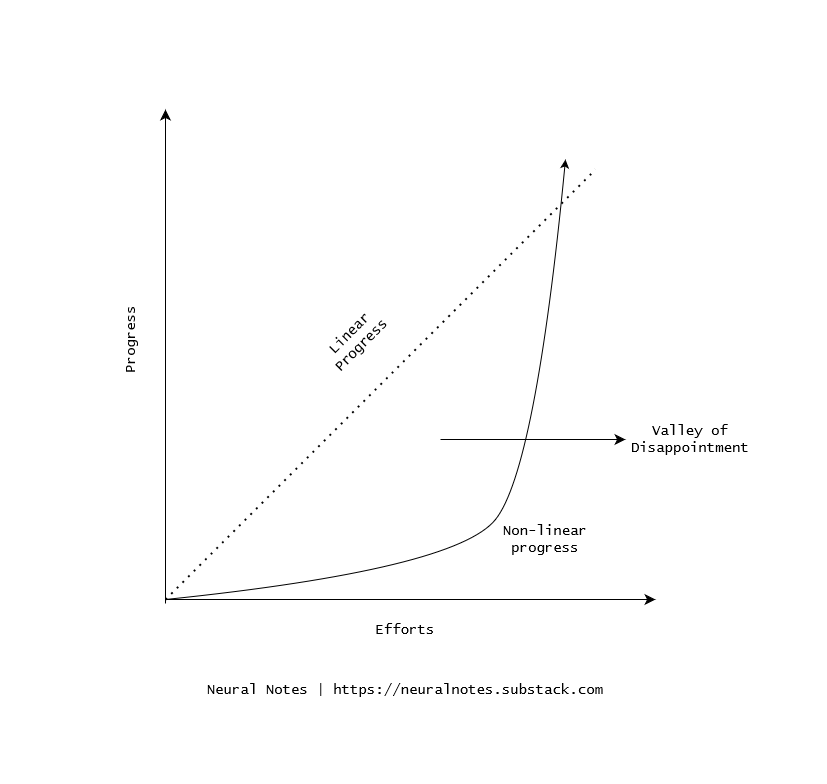Hard Work Doesn't Always Pay Off
Challenges, Plateaus, and Leaps: Navigating Life's Nonlinear Returns

The human brain is naturally inclined to process information in a linear manner. We tend to interpret the relationship between two variables in a manner that suggests an upward shift in X will directly correspond to an increase in Y. Yet, the world we inhabit today is anything but linear. The advent of industrialization has given birth to novel professions and made them ubiquitous, which do not reflect linear rules. Consider, for a moment, the days of old. Our ancestors existed in an environment where inputs promptly translated into immediate outputs.
Linear Vs Non-linear
In certain vocations, individuals dedicate themselves tirelessly, day and night, witnessing minimal to negligible outcomes over the course of years. However, one day, their significant breakthrough arrives. This phenomenon is especially evident in fields such as acting, music, art, research, writing, and others. The point of breakthrough is usually called the Inflection Point. In nonlinear professions, skills assume a secondary role, with luck often taking the steering wheel. Even if a medical professional lacks a private practice, they can still manage to make ends meet through diligent daily effort, collecting valuable experience over time. This experience can eventually be exploited to earn significantly. Such individuals cannot be seen flipping burgers at a local restaurant. On the other hand, there are far more struggling actors serving coffee at Starbucks, hoping to catch a big break, in a scenario where luck wields a much more significant influence than most are willing to acknowledge.
It is natural to struggle, turn despondent, or even consider giving up when you cannot see the fruits of your labor. Our minds are not inherently wired to grasp the intricacies of life's nonlinear patterns.
How Non-linear Works?
Abdul Kareem is a researcher at MIT who’s dabbling with some form of medicine that significantly lowers the growth of cancer-causing cells. He's like a mad scientist, minus the crazy hair—let's be real, that's just a stereotype. He is married to a woman who’s an architect by profession. Abdul goes into a lab that's probably a mouse paradise where he tests his medicine. Seriously, those mice should be paying rent at this point. His wife takes on projects of designing and supervising the construction of elegant design structures at institutions.
During every family gathering, folks approach her with that curious look and ask about her husband's job. She finds herself dumbstruck, or rather ashamed, to tell the relatives that he’s just a researcher who works with smelly rodents. To break the awkward silence when the question is directed at her, she's got her secret weapon: talking confidently about her job of designing stunning buildings for big-shot companies or millionaire mansions.
Year after year, her friends ask her the same old question and she finds herself growing impatient towards her husband who cannot tell her anything new except that he is trying to make the medicine work. She finds herself jealous of her sister, whose husband is a hotshot CEO of some company that he has grown X% since joining. This guy could make a sandwich sound impressive on a resume. Abdul’s wife feels like she was just unlucky to have married a loser. She divorces him after 7 years of their time together.
Then one day, Abdul’s medicine, after 11 years of working hard day and night, ditching social gatherings, and smelling of mice pee every day, finally works. His research is picked up by the New York Times. He’s invited for interviews across TV networks where he’s praised as the “hero”. A pharmaceutical company makes an arrangement with him to manufacture the “miracle med.”
So, where's his architect wife? She's at home, feeling awkward on her sofa all the while turning red with guilt, watching her ex-hubby shine on TV. Remember those friends who used to bug her about success? Now they're like, "Aww, poor you." But wait, there's a twist! At the next family gathering, they feel sorry for her, not Abdul. Life’s funny, isn’t it?
What Abdul’s Wife Failed To Understand
Abdul’s wife had a job where hard work led to steady progress. Every day she went to work, each brick she added to her design showed her that things were moving forward. She could actually see the results of her efforts right in front of her. Her job was one where what she did in X directly gave her results in Y.
What she failed to understand was the non-linear profession her husband was in.
Professions such as Abdul’s can take years off someone’s life before showing even the tiniest glimpse of progress. You work on a project that does not deliver immediate or steady results; all the while, people around you work on projects that do. You are in trouble.
Many folks work hard, believing they're on the right track, but they might not see solid results for quite a while. They've got to be patient, dealing with not-so-nice comments from others without getting down. Their relatives and friends might see them as foolish, and it takes guts to keep going. They don't get any praise, no "good job," no impressed students, and definitely no Nobel Prize or Oscars. When someone asks, "How was your year?" it kind of hurts a bit inside because most of their years might seem like they've gone to waste when others look at their life from the outside.
Such is the lot of scientists, artists, and researchers lost in society rather than living in an insulated community.
Conclusion
Progress is not always a straightforward march from point A to point B, but rather a dance through twists and turns. As we've explored the story of Abdul whose efforts seemed hidden in the shadows of uncertainty, we've discovered a truth that resonates with all of us: Life is not just a predictable equation.
So, the next time life's tempo feels out of sync, when our efforts seem fruitless and the road ahead rocky, let's remember the nonlinear nature of our endeavors. The goal is to focus on the process rather than the destination. We have to learn to push through the Valley of Disappointment to come out on the sunny side of success. Remember, every day we work on non-linear projects, we move a step towards the desired results, perhaps not visibly, but probabilistically.
This advice is particularly for people involved in professions where luck (chance and randomness) plays a far greater role.
This newsletter was born out of the fierce reading of the works of many people, the most prominent of them being Nassim Taleb. If you understand simple graphs and do not wish to be tortured by “reading” this newsletter, I recommend you to watch this video.


